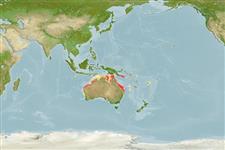Environment: milieu / climate zone / depth range / distribution range
экология
морской демерсальный. Subtropical; 10°S - 32°S
Eastern Indian Ocean: Western Australia. Western Central Pacific: Queensland, Australia.
Size / Вес / Возраст
Maturity: Lm ? range ? - ? cm
Max length : 6.4 cm TL самец/пол неопределен; (Ref. 33839)
Body gibbous; greatest depth 37-40% SL; covered with highly modified scales, each with a small spinous point. Interorbital ridges thick and fused in the middle of interorbit. Dorsal margin of operculum inclined about 35° above horizontal (Ref. 39602).
Found on soft bottomed inshore areas.
Life cycle and mating behavior
Maturities | размножение | Spawnings | Egg(s) | Fecundities | личинки
Paxton, J.R., D.F. Hoese, G.R. Allen and J.E. Hanley, 1989. Pisces. Petromyzontidae to Carangidae. Zoological Catalogue of Australia, Vol. 7. Australian Government Publishing Service, Canberra, 665 p. (Ref. 7300)
Статус Красного Списка МСОП (Ref. 130435)
Угроза для людей
Harmless
Использование человеком
объект спортивного рыболовства: да
дополнительная информация
инструменты
Специальные отчеты
Скачать в формате XML
ресурсы в Интернет
Estimates based on models
Preferred temperature (Ref.
123201): 24.1 - 28.5, mean 26.7 °C (based on 214 cells).
Phylogenetic diversity index (Ref.
82804): PD
50 = 0.6250 [Uniqueness, from 0.5 = low to 2.0 = high].
Bayesian length-weight: a=0.00389 (0.00180 - 0.00842), b=3.12 (2.94 - 3.30), in cm total length, based on all LWR estimates for this body shape (Ref.
93245).
Trophic level (Ref.
69278): 3.3 ±0.3 se; based on size and trophs of closest relatives
Fishing Vulnerability (Ref.
59153): Low vulnerability (10 of 100).
